Nobody comes to Las Vegas hoping they’ll lose. In Vegas, you can’t help but aim to win – and win big. The same goes for sales. But unlike in Vegas, where the path to success is as simple as walking up to a blackjack table, winning in sales takes more time, more energy, and more strategy. That’s where sales enablement comes in.
Attending SiriusDecisions Summit 2018 last week in Las Vegas was extremely informative for those in the sales enablement function. Nearly every session that I attended discussed sales enablement in some regard – and the sessions that I am about to recap went a step further to show how successful sales enablement can lead to big sales and marketing wins.
The State of B2B Content: The Good, the Bad, the Ugly
“Do the best you can until you know better. Then when you know better, do better.”
– Maya Angelou
I don’t want to age myself, but for the better part of my career, content has been at the core of marketing strategy. Yet despite how long content has been a focus, few b2b marketing organisations report an advanced state of content engine maturity. Several organisations still struggle to close the gaps between content strategy, creation, activation, technology, and, most importantly, measurement.
SiriusDecisions urged organisations to identify and prioritise plans to address these critical gaps to improve both content process and performance. One recommendation that stood out from a sales enablement standpoint was to focus on building and improving content measurement dashboards to ensure that content strategy plans are always informed by content performance insights and analytics. While there are certainly solutions that help marketers measure content performance at the top of the funnel in terms of clicks, downloads, likes, and shares, the most compelling content performance insights, such as information about sales asset engagement, must be gleaned from further down in the funnel in order to more closely, or even directly, correlate content to closed-won revenue. Content evolution requires enablement.
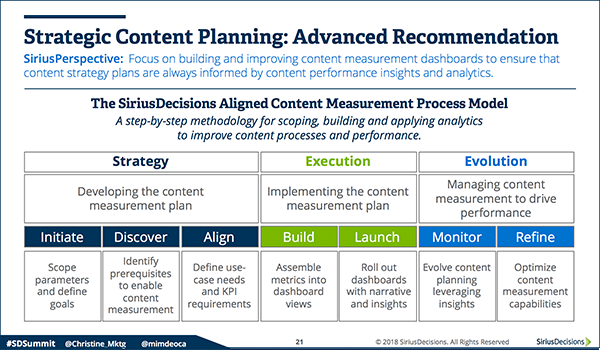
The Content Factory
Because we’re in the process of refining our own content factory here at Highspot, this session caught my interest because it promised to explain how other marketing teams are finding new ways to meet content requirements while still scaling, customising, and measuring content effectively.
During the session, it became clear that most organisations are still missing key guidelines, governance, and technology to support effective content creation, scale, workflow, and measurement. What I found most concerning were the problems that have solutions but aren’t being solved by organisations, such as rogue content creating compliance issues, uncertainty around where to post final content, or time wasted on content repositories that are siloed or require tagging! These are all problems that can be solved with sales enablement – and solved easily, at that.
For the 41% of b2b marketing organisations that have indicated plans to “increase” or “significantly increase” investment in sales asset management during the next 12 months: kudos! You are on the right track to ensuring that your content factory is set up for success.
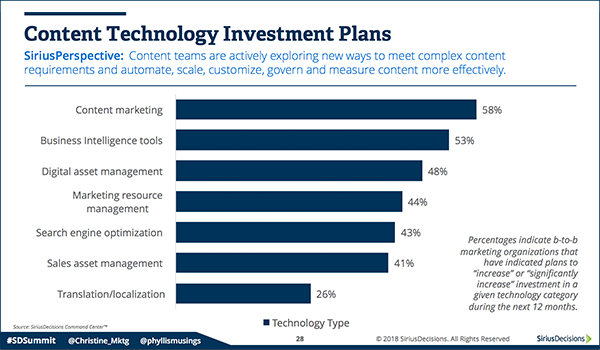
The Future of Demand and Field
Selfishly, I attended two presentations that I thought would prove extremely beneficial to my role leading the demand generation team at Highspot – Demand Creation Infrastructure and Redefining the Field Marketing Job Family – and was pleasantly surprised to hear SiriusDecisions emphasising the importance of enablement to these audiences as well!
Too often, I get into conversations with traditional marketers who think demand and lead gen are one and the same. Having done both types of roles, I assure you that there is a stark contrast. True demand generation flows throughout the customer lifecycle and requires tight alignment between marketing, sales, and customer success teams to deliver the best experience for the buyer.
SiriusDecisions pointed out that the traditional category-led view of the b2b demand technology landscape has resulted in confusion and frustration because they don’t help marketing leaders identify the best options to truly meet their business goals. As you can see in the constellation below, demand creation is at the center of the universe—but doesn’t stop there!
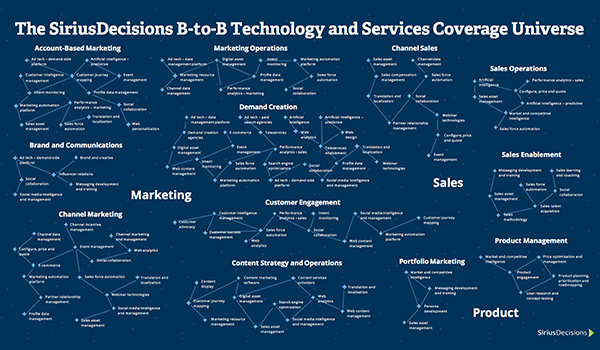
Similarly on the field marketing front, SiriusDecisions shed light on why this role continues to struggle even within the most mature organisations. Sales strategies and roles have significantly evolved in recent years, but in many companies, field marketing has not, making it difficult for field marketers to partner effectively with sales. Too often, field marketers hired for their local market knowledge and tactical execution expertise are being asked to provide specialised strategic support to sales without the tools or techniques to do so. From my perspective, this is an extremely underdeveloped area where sales enablement can help.
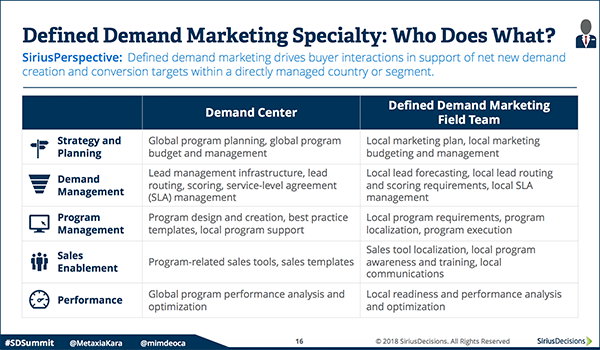
What is Sales Enablement?
Wait – are we still debating this definition? In this session, SiriusDecisions focused less on definition and more on strategic priorities and range of responsibilities that sales enablement should encompass to ensure that it improves sales productivity and drives increased revenue contribution.
Sales Enablement Strategic Priorities:
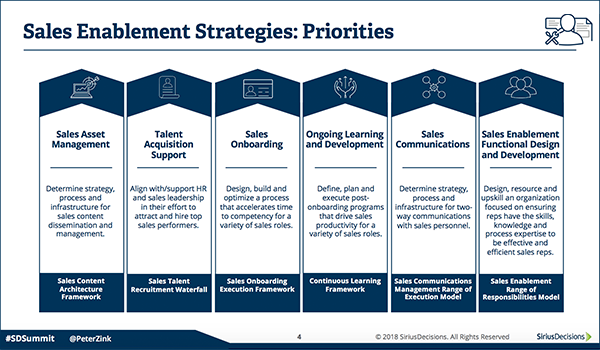
The SiriusDecisions Sales Enablement Range of Responsibilities Model:
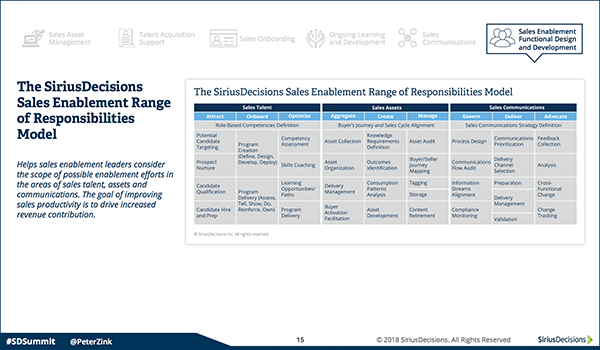
Sales Enablement Plan on a Page
Last, but not least, I attended a hands-on lab focused on building a sales enablement plan on a page. The session started out ironically enough:
“The nicest thing about not planning is that failure comes as a complete surprise and is not preceded by a period of worry and depression.”
– Source Unknown
Why bother with a plan? As sales enablement evolves into a strategic, cross-functional function within an organisation that must leverage expertise across marketing, product, sales leadership, and more to be effective, they are also often asked to take on many programs and initiatives that compete for resources. This is the forcing function for requiring effective prioritisation of tasks. The need for a sales enablement plan is clear, but for many professionals, building an effective plan is not an easy task when faced with a tsunami.
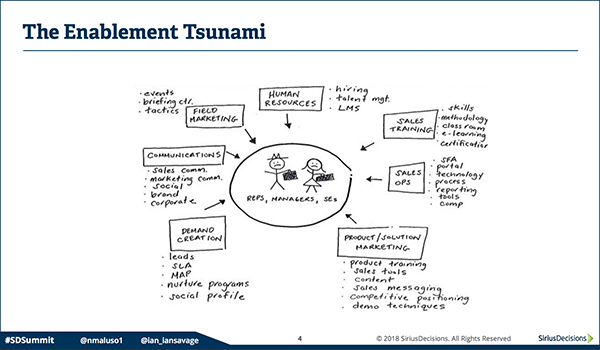
SiriusDecisions recommended starting with the sales enablement charter. What is a sales enablement charter? According to SiriusDecisions, the difference between a sales enablement charter and a plan is as follows:
| Sales Enablement Charter | Sales Enablement Plan |
| Why, what and who? | How? |
| Long-term guiding principles | Focused on 12 to 18 months |
| Overall scope | Aligned to corporate and sales goals |
| Overall expectations | Identifies specific programs and tactics |
| Overall outcomes | Identifies specific outcomes |
The SiriusDecisions Plan on a Page focused on identifying the following critical criteria to ensuring a successful and effective sales enablement plan:
- Key Stakeholder Goals and Strategies: What are the key stakeholder goals? Which goals will sales enablement support, and to which will it align?
- Sales Enablement Priority Programs: How will sales enablement support stakeholder goals?
- Sales Enablement Objectives: What are the objectives of each program?
- Milestone Dates: When will specific deliverables be delivered and impacts be felt? When will certain milestones be met?
- Roles & Responsibilities: Who within sales enablement will run the program (role)? What are their key responsibilities? Whom do they rely on for inputs? Who needs to be aligned with this program? Who is a key audience/customer of this program?
- KPIs: What does success look like? How will sales enablement success be measured? What metrics will be affected? For the sales function? For the business? For other key stakeholder functions?
- Dependencies and Risks: What will cause the plan to fail? What assumptions were made? What risks exist? What mitigation, if any, can be put into place? What opportunities does this open up?
- ROI: What is the expected return on investment? Costs vs. benefits?
At the end of the day, “failing to plan is planning to fail” – and sales enablement is simply too critical to business success to fail. Highspot is one way winning companies succeed.


